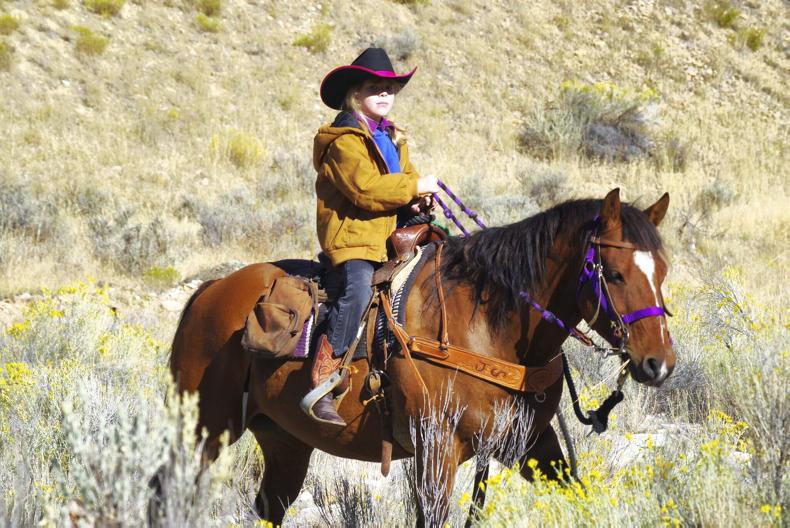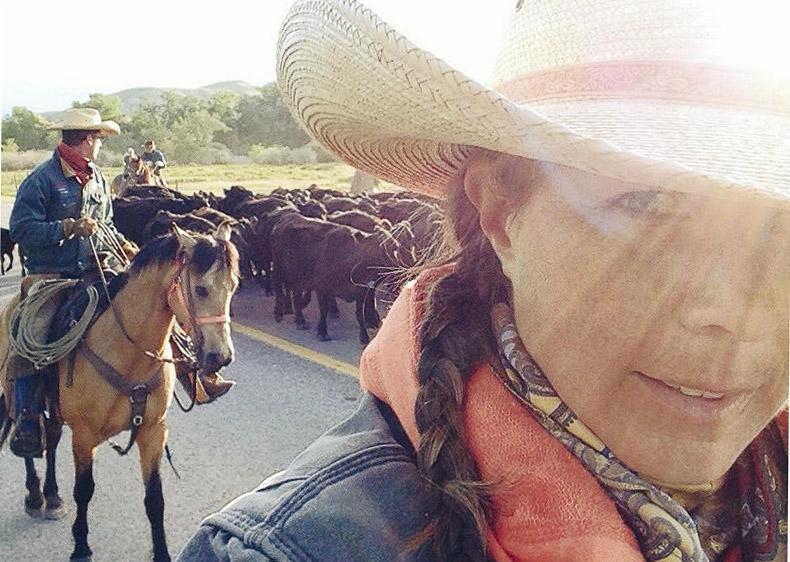The J Lazy S Angus Ranch is located near Salmon, Idaho, in a town called Carmen that has a tiny post office, a community centre and a bar.
We have every type of terrain, starting with beautiful and lush river bottoms to sagebrush-covered hills, sparsely grassed and rocky hills, heavy timber to high mountain meadows and our weather is considered high mountain desert, so we get every season in every extreme.

Temperatures can get as high as 37°C (100°F) and have gotten as low as -34°C (-29°F). We get 60in (1.5m) to 150in (3.8m) of snow in the mountains and usually get a good rainy season in the late spring, about the time we’re trying to dry hay.
Jay’s mother grew up ranching and her family ranch went to her brother, so Jay spent his childhood helping out his uncle and cousins. I’m a country girl, but ranching is two generations back. I grew up helping build homes with my dad.

Shortly after marrying, Jay and I got the opportunity to buy a small ranch and we took it. Our original property is 105ac and we recently purchased 68ac that borders our original property.
We have a split herd of 40 commercial Angus and 80 registered Angus. We lease a 500ac neighbouring ranch and lease another 100 commercial Angus.
We grow our own grass and alfalfa hay, range cows from spring through fall on public lands, raise and sell registered Angus bulls, raise and train our mountain horses, operate a shop that repairs tractors, balers and installs HydraBeds and we both drive bus for a local charter school.
We’re very fortunate to have Jay’s parents help us whenever we need it. Jim and Sue Smith have started a charter school for our community and enjoy spending their spare time riding.

We have two daughters who are about to turn 12 and nine. Both girls enjoy helping out wherever they can, but Carma, our oldest, has just discovered the joy of driving the raking tractor while we hay.
Claira, our youngest, is a daredevil, who pushes the limits of speed on everything she rides, which, lucky for us, is just a tiny four-wheeler that maxes out at 10mph and her trusted pony Clover.

We’ve just been invited to join an established registered Angus bull sale, which is a really big deal, as bulls are sold on the reputation of their bloodlines and the rancher.
We chose black Angus cattle for their do-ability, stay-ability and sale-ability.
Do-ability is being able to thrive in our long, harsh winters and steep, rugged range lands.
Their stay-ability means they not just thrive in these conditions, but last. The cost of developing females in our climate is expensive due to hay, so they need to have a longer life span and breed back every year.

For sale-ability, the Angus Association has done an excellent job of marketing, so there is a high demand for it. Our beef calves are sold by auction between June and August and delivered in November.
Our calves go out to public lands range grazing every May with their mothers and return to the ranch between September and October. They switch to the feedlot-type lifestyle because they can eat very well. Our calves sell at an average of 700lb (317kg) at $1.50/lb (€1.27/kg) liveweight.

It has become increasingly hard to even think about ranching with all the new regulations placed on not only our lands but our animals and practices. We are in a constant battle with people and organisations that want to see cattle gone from our fields and from public lands.
Public lands grazing is something we pay for by the head and, when you count the time we spend repairing and maintaining the land, water ways, troughs and fences, it easily costs twice as much to run a cow on range than to buy irrigated pasture. But it’s a privilege to help keep our mountains, meadows and sagebrush hills and prairies healthy.
Both of our girls have expressed an interest in ranching when they grow up and even though we’d love for them to do just this, there will be zero pressure from us.
Read more
Farmer Writes: suckler farming is at a critical juncture
Farmer Writes: the utter torment of a two-wheel-drive tractor
The J Lazy S Angus Ranch is located near Salmon, Idaho, in a town called Carmen that has a tiny post office, a community centre and a bar.
We have every type of terrain, starting with beautiful and lush river bottoms to sagebrush-covered hills, sparsely grassed and rocky hills, heavy timber to high mountain meadows and our weather is considered high mountain desert, so we get every season in every extreme.

Temperatures can get as high as 37°C (100°F) and have gotten as low as -34°C (-29°F). We get 60in (1.5m) to 150in (3.8m) of snow in the mountains and usually get a good rainy season in the late spring, about the time we’re trying to dry hay.
Jay’s mother grew up ranching and her family ranch went to her brother, so Jay spent his childhood helping out his uncle and cousins. I’m a country girl, but ranching is two generations back. I grew up helping build homes with my dad.

Shortly after marrying, Jay and I got the opportunity to buy a small ranch and we took it. Our original property is 105ac and we recently purchased 68ac that borders our original property.
We have a split herd of 40 commercial Angus and 80 registered Angus. We lease a 500ac neighbouring ranch and lease another 100 commercial Angus.
We grow our own grass and alfalfa hay, range cows from spring through fall on public lands, raise and sell registered Angus bulls, raise and train our mountain horses, operate a shop that repairs tractors, balers and installs HydraBeds and we both drive bus for a local charter school.
We’re very fortunate to have Jay’s parents help us whenever we need it. Jim and Sue Smith have started a charter school for our community and enjoy spending their spare time riding.

We have two daughters who are about to turn 12 and nine. Both girls enjoy helping out wherever they can, but Carma, our oldest, has just discovered the joy of driving the raking tractor while we hay.
Claira, our youngest, is a daredevil, who pushes the limits of speed on everything she rides, which, lucky for us, is just a tiny four-wheeler that maxes out at 10mph and her trusted pony Clover.

We’ve just been invited to join an established registered Angus bull sale, which is a really big deal, as bulls are sold on the reputation of their bloodlines and the rancher.
We chose black Angus cattle for their do-ability, stay-ability and sale-ability.
Do-ability is being able to thrive in our long, harsh winters and steep, rugged range lands.
Their stay-ability means they not just thrive in these conditions, but last. The cost of developing females in our climate is expensive due to hay, so they need to have a longer life span and breed back every year.

For sale-ability, the Angus Association has done an excellent job of marketing, so there is a high demand for it. Our beef calves are sold by auction between June and August and delivered in November.
Our calves go out to public lands range grazing every May with their mothers and return to the ranch between September and October. They switch to the feedlot-type lifestyle because they can eat very well. Our calves sell at an average of 700lb (317kg) at $1.50/lb (€1.27/kg) liveweight.

It has become increasingly hard to even think about ranching with all the new regulations placed on not only our lands but our animals and practices. We are in a constant battle with people and organisations that want to see cattle gone from our fields and from public lands.
Public lands grazing is something we pay for by the head and, when you count the time we spend repairing and maintaining the land, water ways, troughs and fences, it easily costs twice as much to run a cow on range than to buy irrigated pasture. But it’s a privilege to help keep our mountains, meadows and sagebrush hills and prairies healthy.
Both of our girls have expressed an interest in ranching when they grow up and even though we’d love for them to do just this, there will be zero pressure from us.
Read more
Farmer Writes: suckler farming is at a critical juncture
Farmer Writes: the utter torment of a two-wheel-drive tractor












 This is a subscriber-only article
This is a subscriber-only article









SHARING OPTIONS: